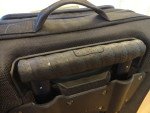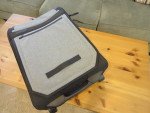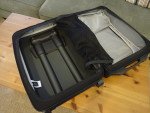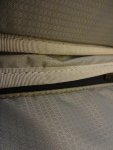The Timbuk2 Copilot is worth your consideration. Timbuk2, the San Francisco-based company best known for their messenger bags, makes a very compelling 2-wheel carry-on in the Copilot. After spending some time with the Copilot, here’s how we would sum up our thoughts: the attention paid to detail is evident throughout, the appearance is handsome and the materials used are of good quality. We like the overall design and find the layout of the bag to be very practical. While we like the bag overall, there is one drawback worth mentioning. Let’s break down this carry-on in detail, discuss its merits as well as opportunities for improvement, in an effort to help you decide if the Timbuk2 Copilot should be yours.
Like all of our bags, we’ve made a video review for this Timbuk2 Co-Pilot that you can watch on our YouTube channel Tekuben Prime or below:
We’ve also made a shorter Quick Look video if you find our regular review video too long:
Tekuben.com is a privately owned, independent website. The views expressed are entirely our own. We do not receive merchandise or payment from manufacturers or retailers to review products. Our work is for and supported by you. In our post, you’ll find orange links to Amazon.com. We earn commission if you make a purchase of any kind on Amazon after clicking on the link. If you would like to buy this Timbuk2 bag, please consider purchasing it from Amazon.com with this link. Doing so will help support our work here at Tekuben. We hope you find the video above and our thoughts of this bag below helpful and we thank you for visiting Tekuben.com
Exterior
Front
The Copilot has a distinctive front. A straight band that cuts across the face of the bag horizontally, a third of the way down from the top, creates a visual separation from the quick access pouch above and the panel pocket below it. The Timbuk2 logo is stitched on the left of the band. A small handle in the lower center of the front tips off a neat feature of the bag that we’ll get to later.
The top pouch has a wide opening zipped up by two YKK sliders on a u-shaped track and is designed to be big and spacious. The actual allowance will depend on how much you pack on the door side compartment since the pouch is not fixed, but rather flexible – giving you the option to allocate more space to the interior or to the pouch depending on your needs. We measured the opening at 11 inches and the depth of the pouch at 9 inches. The front panel of the pouch is padded and the lining takes on a lighter shade than the exterior which helps provide contrast when you’re unpacking.
The panel pocket is standard – one YKK slider on a horizontal track. The front is also padded and it has enough room to fit a tablet or perhaps a small ultra thin notebook, but certainly not this 13″ MacBook Pro that I’m typing on. We measured the width of the opening at 10 inches and the depth at 13.5 inches.
One note about the main compartment’s zippers – both of our units had difficult to zip/unzip sliders; the Midway color bag more so than the Black one. It was a bit frustrating at first when we tried to open the bag as we’ve never experienced such poor zipper sliding performance. Now, we try to view the glass half-full by considering it as a theft deterrent. Even so, it’s by far the biggest disappointment or “con” of this bag. We hope this isn’t the case for all Copilots.
Sides
Each side of the Timbuk2 Copilot has a handle for you to grab hold of. The handles on the top and both sides are simple, thin stitched on bands of nylon. It’s certainly a different design approach than the one taken on the Lipault and Briggs bags that we looked at. The minimalistic design allows more of the external dimension to be allocated to packing space. While they are simplistic, the handles appear to be well made. The top handle is attached to the bag by cross stitchings on either end while the side handles are double stitched on.
There’s a built-in business card sized ID window on the right hand side of the bag. It has a mesh cover that helps to add a layer of privacy. Timbuk2 includes a card that you can fill out with your information so no luggage tags are necessary. This is a good time to point out that the hinge of this clam shell bag is on the right hand side instead of the left hand side as is typical, at least with the bags that we’ve come across so far. It’s a little like reading right to left at first since the bag, like a RTL book, opens to the right.
Unlike the handles on the top and sides, the Copilot’s bottom handle is a bolted on piece of hard plastic that doubles as a foot to balance the bag when upright. Unlike the Brigg’s implementation of a bottom handle (a sleeve tucked into the body), this handle will touch the ground, so keep that in mind when using it, unless that’s something you do not mind.
Back
Whereas the front and sides of the bag are soft shell, the back of the Copilot is a tougher plastic hard shell with what appears to be an abrasion-resistant finish. On this side, you’ll find an exposed handle and 2-wheel system. Like the top and side handles, it’s rough and rugged. The handle bar is ridged and grippy, made to look like it’s wrapped in perforated black tape. It matches the two big, rugged skate board wheels that have no problem going over pavement and cobblestone. What gives it a rough appearance are the two welded joints where the pull bars and the wheel axle connect. There’s also a big plastic plate bolted on by 8 screws that stabilizes the pull bars.
The handlebar has just one height setting. When fully extended, we measured the distance from the top of the handlebar to the ground at 40.5 inches and 39.25 inches from the ground to the bottom of the handlebar. You’ll hear and feel a click on the way to being fully extended but don’t be fooled into thinking it’s the first stop. The handlebar won’t retract if you push down until you activate the mechanism, however it will extend fully upwards if you pull up, even without pressing the button which is located in the top middle of the grippy handlebar.
Interior
Main Compartment
The Timbuk2 Copilot’s interior compartments are sectioned off by zippered mesh panels. The mesh panels help to keep your contents in place when opening the bag up. We like Timbuk2’s decision to use neoprene to anchor the mesh zippers. The material has some give to allow for a bit of overpacking, unlike the fabric used on the door side of the Samsonite Firelite. It’s a single flat piece of mesh on the main compartment (wheel side), while the door side’s mesh panel has two zippered pockets for organization. They are a nice touch but I don’t expect to use them much.
While the handlebars are exposed on the exterior, the wheel-bar system still takes up some room in the main compartment which means the Copilot doesn’t have a flat interior. That’s a feature we’ve really gotten to appreciate since we looked at the Briggs & Riley Baseline International carry-on. Note that the Briggs costs more than double this Timbuk2 so it’s not an equal comparison.
What is unique to the Copilot however, is the front loading panel that allows the traveler to access the door-side interior compartment without having to open the clamshell bag. This would’ve been a very useful feature to have in the wheeled bag we used on our trip to Europe, when we were staying in hostels where space is limited. The front loading capability is one of the primary reasons we recommend the Timbuk2 Copilot.
Summary
The Timbuk2 Copilot roller is one of our favorite 2-wheeled bags of any price point at the moment. The combination of carry-on-able size, materials, big wheels and the front loading panel makes the Copilot an attractive choice for travelers looking for a well designed 2-wheel carry on. While it’s not the lightest bag in its’ class and the zippers are stiff on the ones we have, the Copilot’s features and benefits warrant consideration if you’re searching for a 2-wheel carry-on for less than $200.
If you want someone else to know about this bag, send them this videogram:
Specs
Model: Timbuk2 Copilot Luggage Roller
Size: Small
Color: Midway – Reverse FARP
Style Number: 544-2-1269
Similar Styles: 544-2-2000; 544-2-2960; 544-2-7744
Dimensions (as measured by us here at Tekuben)
21.75″ Tall x 15.25″ Wide x 9.25″ Deep or 55.25 cm x 38.74 cm x 23.5 cm (including handles)
Capacity: 2,563 cu in. or 42L
Weight: 7.8 pounds or 3.54 kilograms
Warranty: Timbuk2 Lifetime Warranty
Ratings (relative to other bags in its class)
-
Weight
-
Carry Capacity
-
Handling
-
Organization
-
Appearance
-
Warranty
-
Value
Summary
Timbuk2, famous for messengers, delivers a compelling 2-wheel carry-on.

































Thanks for the very informative and detailed video review. Given the measurements, would it qualify as a carry-on for airlines with very tight requirements, such as Air France (21 x 13 x 9)? It looks like it’s too wide and deep for even common requirements, like 22 x 14 x 9.
Hi and thank you for asking. Speaking from our experience, we had no problems carrying the Copilot on ANA, Air New Zealand, Quantas, Thai, Air Asia and Southwest. None of them have as strict a requirement as Air France but Quantas and Air Asia came the closest at 22 x 14 x 9. Technically, the Copilot is too big and these airlines have every right to reject them as carry ons but I believe that this bag passes the “eye test” for those airlines, if only barely. If it were any bigger, it would likely be questioned, measured and rejected.… Read more »
Thanks for the first-hand report. I’m going to pull the trigger on this bag. It looks like it will suit my needs well.
Great. Let us know how you like it.
Thanks for the detailed review! Question though, in the second picture under “Main Compartment” there are zippers that go along the sides. What function do those have?
Thank you for asking. You have a good eye! That zipper running on the inside of the main compartment provides access to a compartment that houses a plastic strip. The plastic strip appears to provide structure and add rigidity to the frame of the suitcase. Made a video for you to see: https://youtu.be/25U9VKYcxRw
Thank you for your review. And this review was done in 2016. How has the bag held up since then?